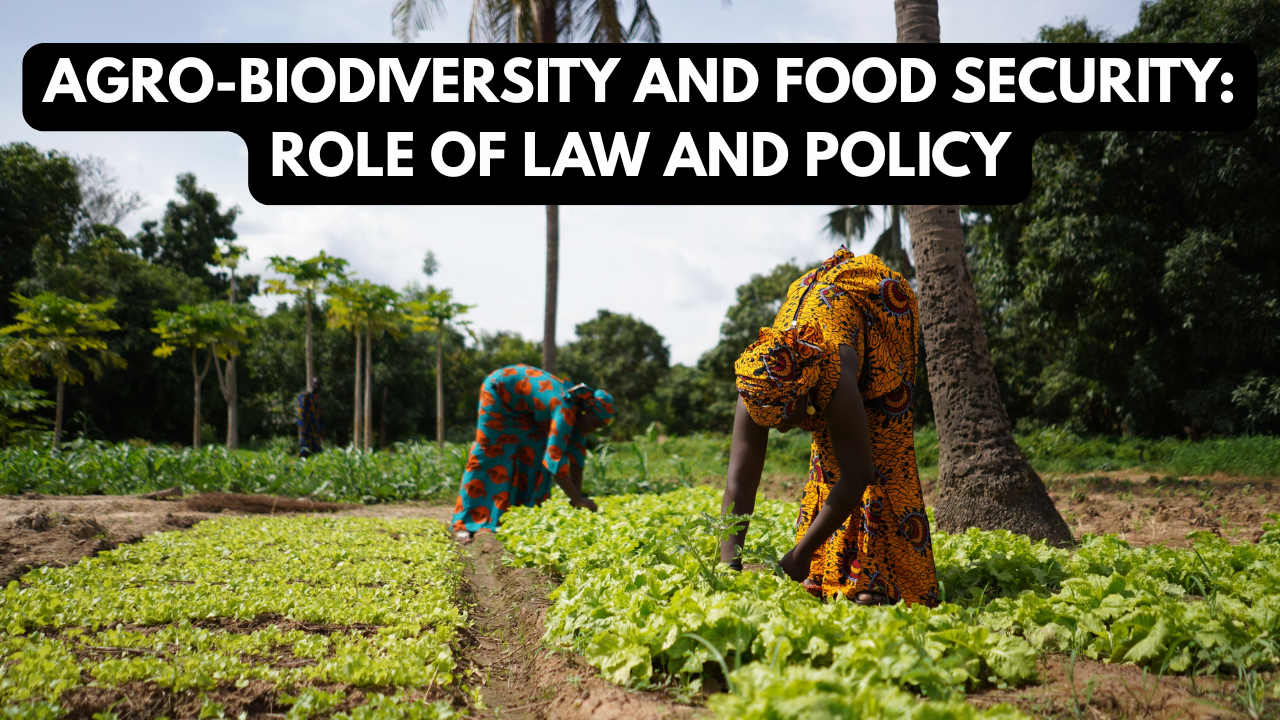
Agro-biodiversity, or agricultural biodiversity, refers to the variety of plants, animals, and microorganisms essential for food production and agriculture. It includes traditional crop varieties, livestock breeds, soil organisms, and pollinators that support ecosystems and human well-being. In the face of climate change, population growth, and industrialized farming, agro-biodiversity has become a critical pillar of food security. The role of law and policy is central in ensuring its protection, sustainable use, and equitable sharing of benefits.
Importance of Agro-Biodiversity in Food Security
- Nutritional Security: A diverse food base ensures balanced diets and reduces dependence on a few staple crops.
- Climate Resilience: Traditional crops and indigenous livestock breeds are better adapted to local conditions and can withstand droughts, floods, and pests.
- Sustainable Agriculture: Agro-biodiversity maintains soil health, enhances pollination, and reduces the need for chemical inputs.
- Cultural Heritage: Local communities preserve knowledge of seeds, farming practices, and biodiversity essential for survival.
Threats to Agro-Biodiversity
- Monoculture Farming: Focus on high-yield varieties reduces genetic diversity.
- Climate Change: Rising temperatures and erratic rainfall threaten traditional crops.
- Commercial Seed Systems: Dependence on genetically modified and hybrid seeds undermines local seed sovereignty.
- Overexploitation: Unsustainable farming, pesticide use, and habitat loss deplete agro-ecosystems.
- Weak Legal Protection: Lack of effective policies often leaves farmers and indigenous knowledge unprotected.
Legal and Policy Framework in India
India, a mega-diverse country, has introduced several laws and policies to conserve agro-biodiversity while ensuring food security.
- Biological Diversity Act, 2002
- Protects biodiversity and ensures benefit-sharing from its use.
- Recognizes community rights over local biological resources.
- Protection of Plant Varieties and Farmers’ Rights (PPV&FR) Act, 2001
- Farmers can save, use, exchange, and sell seeds of protected varieties.
- Encourages plant breeding while protecting farmers’ traditional practices.
- Seed Act, 1966 and Seed Bill (proposed amendments)
- Regulates seed quality and certification.
- Concerns remain regarding farmers’ rights under the proposed amendments.
- National Biodiversity Authority (NBA) and State Biodiversity Boards
- Regulate access to biological resources.
- Document and preserve traditional agricultural knowledge through People’s Biodiversity Registers.
- International Commitments
- India is a signatory to the Convention on Biological Diversity (CBD) and the International Treaty on Plant Genetic Resources for Food and Agriculture (ITPGRFA), which promote conservation and equitable benefit-sharing.
Role of Policy in Strengthening Food Security
- Agro-Ecological Policies: Encouraging organic farming and traditional seed systems.
- Public Distribution System (PDS): Inclusion of diverse grains (e.g., millets) to improve nutrition.
- Millet Mission (2023 as International Year of Millets): Promoting indigenous crops as climate-resilient food sources.
- Conservation Incentives: Subsidies and support for farmers preserving traditional varieties.
- Research and Education: Agricultural universities and seed banks play a role in maintaining genetic diversity.
Comparative Table: Laws and Policies Supporting Agro-Biodiversity
| Law/Policy | Objective | Key Provisions | Impact on Food Security |
|---|---|---|---|
| Biological Diversity Act, 2002 | Conservation and benefit-sharing | Local resource protection, community rights | Preserves indigenous crops and farming systems |
| PPV&FR Act, 2001 | Farmers’ rights and plant breeding | Farmers can save/exchange seeds | Strengthens seed sovereignty |
| Seed Act, 1966 & Amendments | Seed regulation and certification | Ensures seed quality, but may restrict farmers | Balances quality with access issues |
| National Biodiversity Authority | Oversight of biodiversity resources | Maintains biodiversity registers | Protects traditional farming knowledge |
| International Treaties (CBD, ITPGRFA) | Global biodiversity conservation | Access and benefit-sharing frameworks | Aligns India with global biodiversity goals |
Lessons and Way Forward
- Promote Local Crops: Encourage millet, pulses, and native varieties in government food programs.
- Strengthen Farmers’ Rights: Ensure laws favor farmers’ seed sovereignty rather than corporate seed control.
- Enhance Research: Invest in agro-biodiversity research and gene banks.
- Mainstream Climate-Resilient Agriculture: Policies must integrate biodiversity with adaptation strategies.
- Community Participation: Empower local communities in decision-making and biodiversity conservation.
Overview Table
| Aspect | Importance | Legal/Policy Support | Challenges Remaining |
|---|---|---|---|
| Crop Diversity | Ensures balanced nutrition | PPV&FR Act, Seed Act | Threat from monoculture farming |
| Indigenous Knowledge | Traditional resilience strategies | Biodiversity Registers, NBA | Erosion of cultural practices |
| Farmers’ Rights | Seed sovereignty and livelihood | PPV&FR Act, Biological Diversity Act | Corporate seed dominance |
| Food Distribution | Ensures access to diverse food | PDS, Millet Promotion Policies | Focus on rice/wheat monoculture |
| Global Frameworks | Aligns with conservation goals | CBD, ITPGRFA | Implementation challenges |
Conclusion
Agro-biodiversity is not just about conserving seeds or crops—it is about securing the very foundation of food security, cultural identity, and ecological resilience. Legal frameworks like the PPV&FR Act and the Biodiversity Act provide essential protection, but gaps remain in implementation. To ensure a sustainable future, India must strengthen farmer-centric policies, encourage traditional crop cultivation, and integrate biodiversity into climate adaptation strategies. Only then can agro-biodiversity truly serve as the backbone of national and global food security.
FAQs
Q1. How does agro-biodiversity contribute to food security?
It enhances nutrition, improves climate resilience, and reduces dependence on a few staple crops.
Q2. What are the key laws protecting agro-biodiversity in India?
The Biological Diversity Act (2002) and the PPV&FR Act (2001) are the most significant.
Q3. Why is millet promotion linked to agro-biodiversity?
Millets are climate-resilient, nutritious, and represent traditional crops vital for sustainable food systems.

